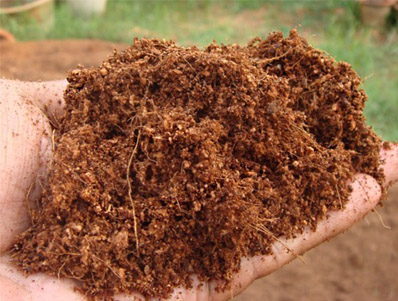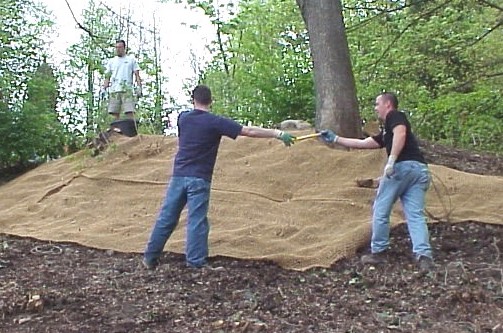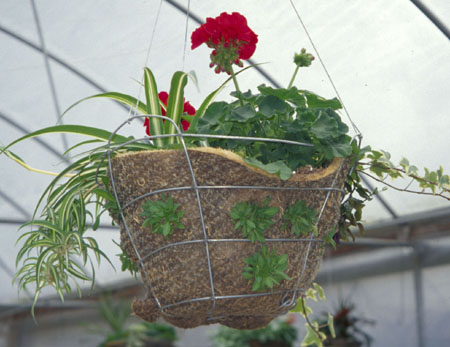Peat v. Coir
New thinking about soil amendments
By Ann M. Mason, Fairfax Master Gardener Intern

Coir
But the practice of using peat moss to amend garden soil is no longer the go-to recommendation. While peat is relatively inexpensive and does successfully aerate soil, it is not a sustainable or eco-friendly product.
Peat moss forms when sphagnum moss compresses and decays in water-saturated bogs—a process that can take thousands of years. Left untouched, peat acts as a carbon sink, absorbing carbon dioxide from the atmosphere. Draining and removing peat, however, reverses the process and releases greenhouse gases (carbon dioxide and nitrous oxide) into the air. In addition, while undisturbed peatlands mitigate and store water during heavy rainfall, removing peat changes water-flow direction, which can contribute to flooding and to nutrient leaching. Because peat harvesting causes these negative environmental issues, many scientists and Cooperative Extension Services no longer recommend using peat as a soil additive.
Scientists looking for an alternative to peat that still offers soil-lightening capabilities seem to have found a viable answer in coir. Coir, also called coir pith or coconut dust, is essentially the waste of the coconut. In parts of the world where coconuts are harvested commercially, huge stockpiles of aged coir readily exist. Peat and coir have similar properties and characteristics, making trading one for the other feasible and, in some cases, preferable:
- Coir has a neutral pH (approximately 6) which differs from the acidic pH of peat. Coir does not need an addition of lime, which would increase the pH above the level for optimum plant growth. At pH of about 4, peat by itself is more acidic than many plants prefer.
- Coir has extremely high potassium content and low calcium content, which means gardeners do not need to add potassium fertilizers but will need to add calcium, such as calcium sulfate (gypsum), to the soil for plant uptake. Coir is rich in various micronutrients including iron, manganese, zinc and copper. Gardeners will need to add nitrogen to coir to compensate for its limited ability to allow nitrogen uptake by plants.
- Coir has high water-retention capacity. Peat retains moisture if kept moist; but once dry, peat is very hard to rewet and will shed water.
- Coir has equal portions of lignin and cellulose and is free of seeds and sticks that are found in peat.
- The particle size distribution for both coir and peat is in the range of 0.25-2.5 millimeters, which is the suggested range for optimal plant growth.

Coir mat for erosion control

Coir hanging basket
Here are some broad findings of use to gardeners:
- A mixture of 50 percent coir and 50 percent vermiculite compares well to the industry standard of 75 percent peat and 25 percent perlite for the germination and growth of tomatoes and peppers.
- All coir mixtures need added calcium (gypsum) for plant growth.
- The neutral pH of coir is more compatible with a wide range of plants.
- Water retention of coir is higher than peat and growers need to be mindful not to overwater coir grown plants, especially in winter fruit production.
- Coir from various parts of the world differ in their salinity (using electrical conductivity testing as a measure). Coir from Sri Lanka appears to have electrical conductivity comparable to peat. In contrast, some coir sources, notably those from Mexico, have higher salinity and some plant species, but not all, can adapt to it.
References
• Coir and an Alternative to Peat in Media for Tomato Transplant Production, HortScience 37(2):309-312,
University of Florida, Southwest Florida Research Education Center
• A Comparison of Coconut Coir and Sphagnum Peat as Soil-less Media Components for Plant Growth,
Hydroponics/Soilless Media, Paper 1, Utah State University
• Coir is Sustainable Alterative to Peat Moss in the Garden, Oregon State University Extension Service
• Soil Amendments, Washington State University, Spokane County Extension Master Gardener Program
Publication C130
• Coconut Coir as an Alternative to Peat Media for Vegetable Transplant Production, University of Florida,
Southwest Florida Research Education Center (SWFREC)
• Coconut Coir vs Peat Moss, Washington State University, Kittitas County Extension, Master Gardener
Program